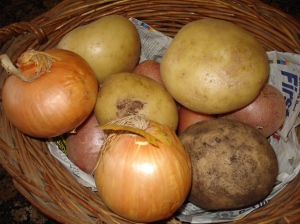Last week when I wrote about the virtues of eating the skins and peels of fruit and vegetables, I left out one of the most important things: taste. Friends have reminded me that foods often taste better with their peels, which of course I knew but forgot to say. But really, that’s what it’s all about, isn’t it? Appearance adds to the appeal, and a variety of textures adds interest to the daily requirement to eat, but good looks with no taste is pretty disappointing. I’d rather have a clear thin broth with bags of flavour than a hearty-looking but bland stew. Which leads me to today’s real theme: making soup/stock.
I’ve been making soup from both fresh and leftover ingredients for a good thirty years now. To be honest, my early efforts were reasonably nutritious but lacked interest. Basically, I would put everything in a pot with lots of water and cook it. The most memorable of these soups was a turkey soup I made with Thanksgiving leftovers: a 24 pound bird had been acquired to serve two adults and two toddlers–and it was a beautiful, satisfying feast. But leftovers were banned, and I couldn’t let it all go to waste. We ended up with 3 1/2 gallons of soup in pint freezer boxes. Very bland, very thin soup. Which the kids and I ate for lunch about once a week until that marriage broke up and we moved house.
Early on, a friend kindly suggested adding seasoned salt and some sort of thickener to the soups when they came out of the freezer. This set me on the path of improved soups, which I continue to follow today. I love watching TV chefs–sometimes I use their ideas right away, and sometimes a stray comment will come back to me months or years later. One of the tips I’ve picked up along this road is about using skins.
Along with all the skins and peels people happily eat, there are others which, while they won’t make you sick, with the best will in the world, are difficult to swallow. Like papery onion skins.
If you’re making a soup from first principles, to serve on the day, obviously you can’t include things that nobody can swallow. But if you’re making stock to use later, that’s another story. Peeling a bunch of onions for some recipe? Pop the skins and small bits of flesh into a stock pot. Add some chunks of carrot/peel/tops, and any other clean but tough rejects, like leek greens. If you include potato bits/peels, you’ll get a cloudy stock. If you include parsnip/peels, the stock will take on a sweet aspect–but do note that a little goes a long way. The skins from already-cooked squashes add flavour and rich colour, especially if they carmelized in the oven. Beetroot skins, unsurprisingly, add a hint of red. You can include a bouquet garni at this point, or wait to add seasoning when you want to use the stock.
Shove everything down in your stock pot, cover with just enough cold water to be able to stir it, put the lid on and bring to a boil. Reduce to simmer for an hour or so–when the liquid has taken on colour and flavour. The longer you simmer, the more concentrated the flavour, but you risk boiling it dry. Remove from heat. Strain through a colander; discard solids. Portion out into freezer boxes–I still use pints, which are a convenient size for recipes for two. Label and freeze. They’ll keep for months.
Enjoy making the most of your food!











I’ve recently started making my own soups and these are some great flavoring suggestions.
LikeLiked by 1 person
Thanks, Laura!
LikeLike
Making stock is something I have never done, *blush* however, I will change my wasteful ways and follow your suggestions.
Thank you.
LikeLiked by 1 person
I’m still learning loads in the kitchen, with plenty of things I haven’t tried yet. I’ll have more on stock options in the near future!
LikeLike
[…] simple way to use an uncooked carcass is similar to my earliest attempts with homemade soup: Start by putting your raw bones in a good sized pan or stock pot and cover with just enough […]
LikeLike